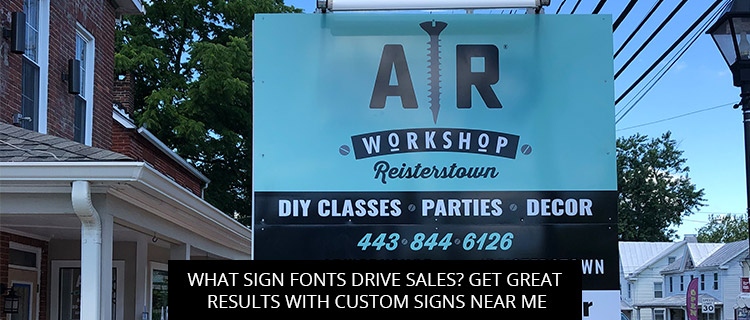

May 27,2022

Believe it or not, sign font is one of the most important factors affecting custom sign visibility. To help you choose wisely, we’ve gathered key findings from sign studies on font selection and letter case.
Read on to review the research, or call (410)-877-6011 to speak directly with a custom sign shop near you.
In a 2017 report for the Interdisciplinary Journal of Signage and Wayfinding, research lead John Bullough ranked all of the factors affecting sign visibility, conspicuity, and legibility, and font selection came out on top, beating out color, sign environment, and letter size.
Thus, if you want great results on your custom sign design, you need to choose the right font, and our custom design team is here to help.
Plenty of research has been published on which sign fonts work best, and we’ve summarized some key findings below:
In addition to selecting a font, you’ll need to decide which letter case to use. Depending on your unique brand vision and sign goals, you may choose uppercase (i.e. capital letters or majuscule letters), lowercase (formally known as minuscule letters), or mixed-case.
Using strictly lowercase letters, with no capitalization whatsoever, can create a sense of playfulness, childlike whimsy, and understated elegance, but it can also negatively affect readability, making it harder for viewers to identify brand names or the start of new sentences without the benefit of capitalization.
In contrast, using all uppercase letters can make your message seem more bold and commanding, but it can also give readers the sense they’re being yelled at, and studies have shown that majuscule messages are harder to read at-a-glance. One such study, conducted by Transportation Research Record back in the late 90s, found that messages written in uppercase were more than twice as difficult for drivers to read, compared to mixed-case messages (Garvey et al., 1997). This isn’t hard to understand, since the vast majority of text we encounter and read throughout the day, be it on websites, in books, or through text messaging, is written with mixed-case letters.
As a general rule, mixed-case sign copy is recommended for custom signs, but it depends on the individual. To get expert advice on which letter case would work best for your custom sign design, get in touch with our team—every consultation is free, and we offer 1-hour of free design time upfront for new customers who put down their deposit.
Call (410)-877-6011 or request a quote online to get your custom sign design started today!
References
Arditi, A., & Cho, J. (2005). Serifs and font legibility. Vision research, 45(23), 2926-2933.
Arditi, A., Liu, L., & Lynn, W. (1997). Legibility of outline and solid fonts with wide and narrow spacing. Trends in optics and photonics, series, 11, 52-56.
Bullough, J. (2017). Factors affecting sign visibility, conspicuity, and legibility: Review and annotated bibliography. Interdisciplinary Journal of Signage and Wayfinding, 1(2), 2-25.
Garvey, P. M., Pietrucha, M. T., & Meeker, D. (1997). Effects of font and capitalization on
legibility of guide signs. Transportation Research Record, 1605(1), 73-79.
Garvey, P. M., Eie, W. Y., & Klenna, M. J. (2016). The effect of font characteristics on large format display. Interdisciplinary Journal of Signage and Wayfinding, 1(1).
Nicole Parker
Nov, 2025
Daniel Grant
Oct, 2025
Nyasha Miller
Sep, 2025
WasteStrategiesPPC
Sep, 2025
Daniel Khoshkharaman
Sep, 2025
Kathy Cooper
Feb, 2025
Carrie McCubbin
Jun, 2025
Dana Jones
Jun, 2025
Isak Kuny
May, 2025
Stacey Schiano
May, 2025
STACEY GEIMAN
May, 2025
Krystal Lawton
May, 2025
John Ceselsky
May, 2025
Tim Thompson
Aug, 2024
Stephen O Dare
Dec, 2024
RealCarGirlsMatterTV DatPankCherokee
Dec, 2024
Richard Matuszak
Nov, 2024
Sean Lewis
Oct, 2024
Harry Caughey
Sep, 2024
Zakira W
Sep, 2024
Lizzie Bellinger
Aug, 2024
Larry Wills
Aug, 2024
Noam Efron
Jul, 2024
Scott Simmons
Jul, 2024
Gary Campbell
Jul, 2024
bdunks
Jun, 2024
Kim Huntley
May, 2024
Brian Leonardi
May, 2024
Jack Woloszyn
Apr, 2024
Garry Gill
Apr, 2024
Lorraine Sann
Apr, 2024
Hilary Fosler
Mar, 2024
Ben Supik
Dec, 2023
Rich Young
Jan, 2024
samuel keitu
Dec, 2023
Ron Sand
Nov, 2023
Megan Gadsby
Oct, 2023
Dr. Adam Summers
Oct, 2023
Monica Rowlands
Oct, 2023
Maura Dwyer
Oct, 2023
Alexia Jones
Sep, 2023
Roxanne VanPelt
Oct, 2022
George Stone
Jul, 2023
john Weiman-CPLC
Jul, 2023